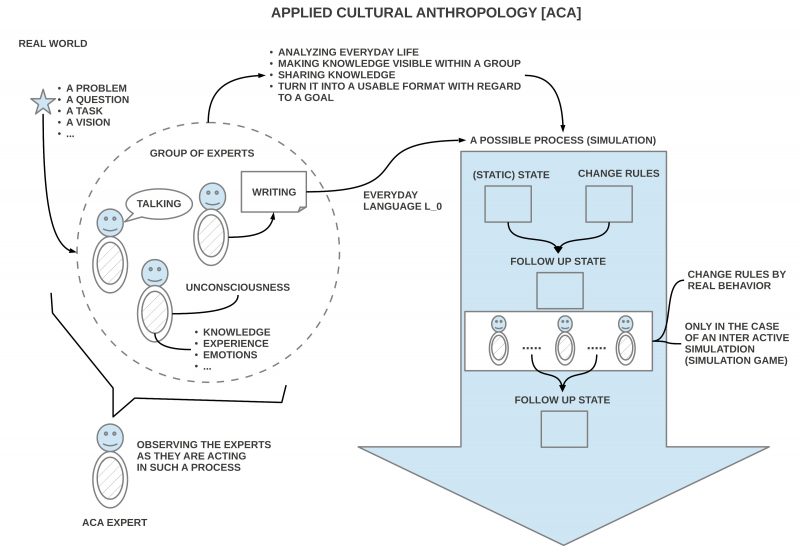eJournal: uffmm.org
ISSN 2567-6458, 28.Aug 2021 – Dec 1, 2021
Email: info@uffmm.org
Author: Gerd Doeben-Henisch
Email: gerd@doeben-henisch.de
CONTEXT
This post is part of the uffmm science blog and will introduce in the new possibility to use the oksimo software for theory development and theory testing using only everyday language. More options are possible.
PREFACE
What has an engineering blog to do with ‘democracy’ [1]-[5], even with ‘sustainable democracies’?
The answer to this question is embedded in the history of the engineering process which led to this post and in this post to the idea of defining a process model for an engineering process with a strong integration of the human-machine interaction perspective. When this has been solved in a first step another requirement showed up: generalize the engineering process for every kind of solution processes with every kind of experts. Design a solution process using only normal language, and make the requirements and possible goals to parts of the process itself. Allow any kind of artificial intelligence and/ or machine learning.
This requirement has been influenced by the application scenario that citizens of a city should be enabled to participate without any restrictions in the communal planning process.
During the elaboration of this requirement it became clear, that a process model which is able to offer a sufficient environment for citizens is ‘as such’ capable to be a process for every assembly of experts.
Such a process is by design a self-organizing process, enabling dynamic diversity, and produces — by design — empirical theories. If you will apply to such a process, then you will inevitably produce a complete theory.
This is of some interest, but doing this there is no need to think about ‘democracy’.
But, if you start reflecting about the conditions of a self-organizing processes enabling a dynamic diversity then you can see, that such processes need a certain type of environment without which dynamic diversity is not possible.
The main motivation behind diversity, even dynamic diversity, is the overall aspect of survival on a dynamic planet like the earth embedded in a dynamic solar system, galaxies, the universe. Biological life has succeeded about 3.5 Billion years because it has a dynamic structure enabling by design lots of innovations in advance to be prepared if the situation is changing. With the advent of homo sapiens and the outstanding capabilities of homo sapiens all processes have been accelerating a lot thereby producing kinds of complexities completely unknown before and faster than the traditional formats of knowledge and learning could cope with. This is a radical challenge to intensify communication, to enable radical openness and diversity, to improve communication and knowledge technologies, to format the whole society as an intensive living organism.
From all known societal organizational structures so-called democratic structures offer the most of freedom and variety to enable such processes. On the other hand it is well known that the ‘freedom to act in diversity’ is no guarantee to do it in the right way. Democracies are not protected against failure. But seen from a principal thinking are so-called democracies the best environment for a self-organizing dynamic diversity producing optimal empirical theories. And — this is some flavor of an autopoietic system — having enabled and set up such self-organizing dynamic diversities producing optimal empirical theories is the best support for a sustaining democracy.
This is the logic behind the decision, to see a sustainable democracy as a systemic part for self-organizing dynamic diversities producing optimal empirical theories and vice versa.
The software which is offering application spaces for self-organizing dynamic diversities producing optimal empirical theories is called oksimo and is available on oksimo.com. Ongoing descriptions with examples and theoretical considerations are presented on oksimo.org. At the time of this writing — 28.Aug 2021 — this blog is nearly completely in German only because of lack of resources.
COMMENTS
[1] The website of the V-dem institute, which is a prominent place for empirical research to democracies world-wide: https://www.v-dem.net/en/
[2] Here you can find regular reports: https://www.v-dem.net/en/publications/democracy-reports/
[3] Here you can find interactive graphical user interfaces to work with the data sets : https://www.v-dem.net/en/online-graphing/
[4] Example with the concept ‚Egalitarian Democracy‘: https://www.v-dem.net/en/news/egalitarian-democracy/
[5] Video about an workshop organized by V-dem: https://www.youtube.com/watch?v=ARBBiMgJT7A
CONTRIBUTIONS
- SUSTAINABLE DEVELOPMENT – The Flying Ideas Iniative (Last Change: Dec 1, 2021)

